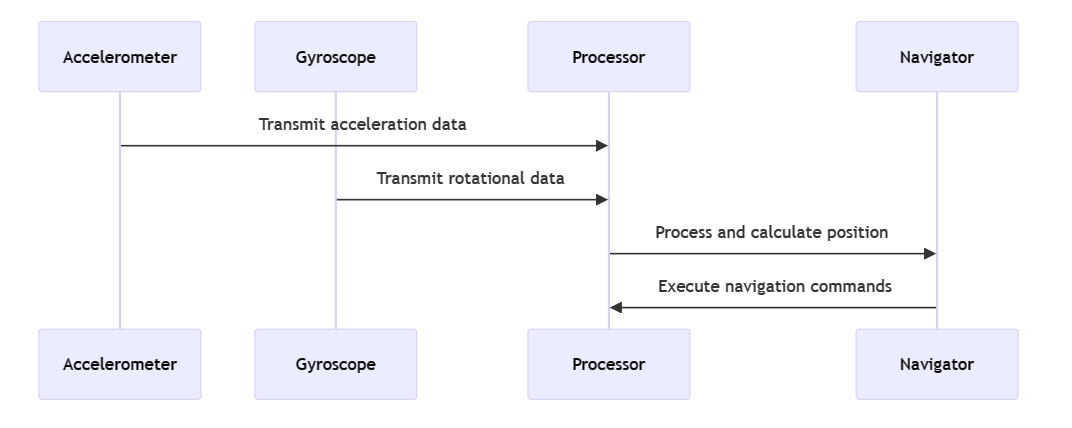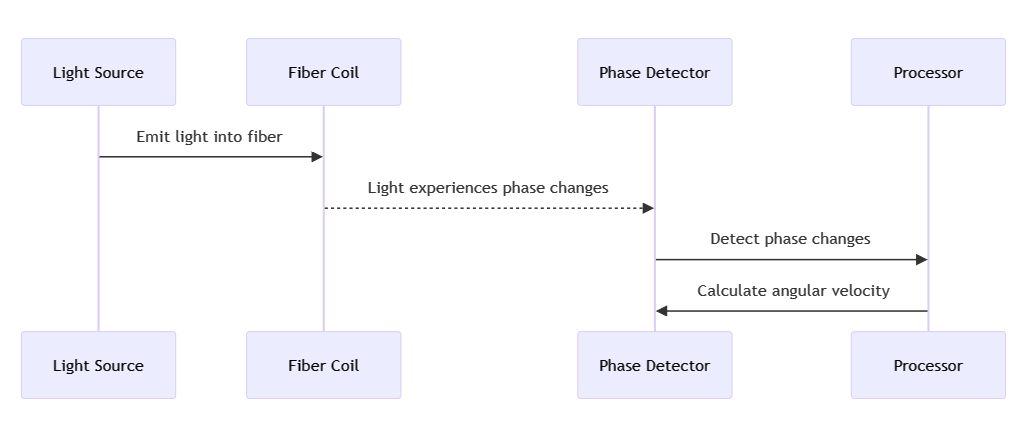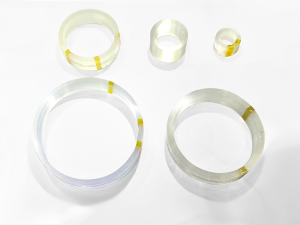Inertial Navigation Systems (INS) represent a cornerstone of contemporary autonomous navigation technologies, operating independently of external signals. Within these systems, the integration of Fiber Optic Gyroscopes (FOGs) and Polarization-Maintaining Fiber Loops is critical. This paper delves into the operational principles of these components, their synergistic relationship, and the nuances of their integration, contributing to the precision and reliability of INS.
Inertial Navigation Systems (INS) are highly sophisticated technologies that calculate an object's position, orientation, and velocity without reliance on external references (Groves, 2008). Central to these systems are Fiber Optic Gyroscopes (FOGs) and Polarization-Maintaining Fiber Loops, whose precision significantly influences the system's overall performance.

Schematic of an Inertial Navigation System
(This diagram can illustrate how different components within the Inertial Navigation System (INS) interact with each other. It will show the sequence of operations starting from receiving signals, processing these signals, and then executing necessary actions based on these signals.)
Comprising accelerometers and gyroscopes, INS measure linear acceleration and angular velocity, utilizing these parameters to compute changes in position and orientation over time (El-Sheimy, Hou, & Niu, 2019). One of the system's paramount advantages is its immunity to signal interference, a critical feature for applications in challenging environments such as deep-sea navigation or aerospace ventures.
Achieving optimal navigational accuracy necessitates the meticulous integration of Polarization-Maintaining Fiber Loops and FOGs within the INS. This involves maintaining operational integrity under specified environmental conditions and employing precision electronics to interpret sensor outputs accurately. Additionally, software within the system must be optimized to process data from various sensors, ensuring precise navigational information.

Fiber Optic Gyroscope Operational Sequence
This diagram can depict the operational sequence within a Fiber Optic Gyroscope, highlighting the process from light transmission through the fiber coil, phase change detection, to the calculation of angular velocity.
As the FOG rotates, two light beams transmitted through the Polarization-Maintaining Fiber Loop undergo distinct phase changes. By analyzing these alterations, the system can deduce angular velocity with remarkable precision.
Polarization-Maintaining Fibers, by sustaining stable light polarization, mitigate light scattering and beam splitting, thereby enhancing signal clarity and ensuring more accurate readings.
The insensitivity of Polarization-Maintaining Fibers to temperature fluctuations and vibrational disturbances minimizes the environmental impact on FOG performance.
The efficacy of Polarization-Maintaining Fiber Loops in mitigating environmental influences on FOG performance is attributed to their unique structural design and the implementation of quad-stage symmetric coiling technology. These innovations aim to minimize adverse effects caused by temperature variations and mechanical stress, known as the Shupe effect.
The structural design of Polarization-Maintaining Fiber Loops is commendably versatile, accommodating various fiber types. This flexibility ensures the customization of the fiber loop to meet specific application demands, providing optimal performance across diverse environmental conditions and application scenarios.
This specialized fiber coiling method minimizes stress and temperature gradients within the fiber, enabling the loop to maintain high stability and reliability under varying thermal and mechanical conditions.
The performance of Polarization-Maintaining Fiber Loops is contingent on their fundamental construction, influenced by the coiling technique, adhesive materials, and fiber types employed. These elements collectively determine the loop's quality and efficacy.
The coiling approach directly impacts the geometric parameters of the fiber loop, including its length, aspect ratio, and overall height, which are crucial for the loop's performance and applicability.
Adhesives play a pivotal role in the manufacturing process of Polarization-Maintaining Fiber Loops. The choice of suitable adhesive materials and curing techniques is essential for producing high-performance fiber loops.
The selection of fiber types is also a significant factor. Different fibers, such as panda-type polarization-maintaining fibers or photonic crystal fibers, possess distinct physical and chemical properties that influence the loop's performance.

Fiber Gyro Coil From LumiSpot Tech ( Lumimetric's Headquater)
| Product Name | Inner Diameter | Diameter | Working Wavelength | Winding Method | Working Temperature |
| FOGs Coil | 13mm-150mm | 100nm/135nm/165nm/250nm | 1310nm/1550nm | 4/8/16 Pole | -45 ~ 70℃ |
More Info can be found via www.lumispot-tech.com
References:
Groves, P. D. (2008). Introduction to Inertial Navigation. The Journal of Navigation, 61(1), 13-28.
El-Sheimy, N., Hou, H., & Niu, X. (2019). Inertial sensors technologies for navigation applications: state of the art. Satellite Navigation, 1(1), 1-15.
Woodman, O. J. (2007). An introduction to inertial navigation. University of Cambridge, Computer Laboratory, UCAM-CL-TR-696.
Chatila, R., & Laumond, J. P. (1985). Position referencing and consistent world modeling for mobile robots. In Proceedings of the 1985 IEEE International Conference on Robotics and Automation (Vol. 2, pp. 138-145). IEEE.
Contact: Lumispot
Phone: +86-15072320922
Tel: +86-510-87381808
Email: sales@lumispot.cn
Add: Bldg 4 No.99 Fu Rong 3rd Road, Wuxi, China